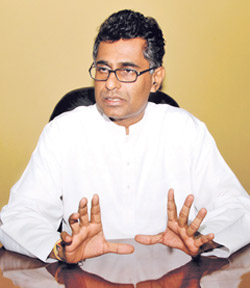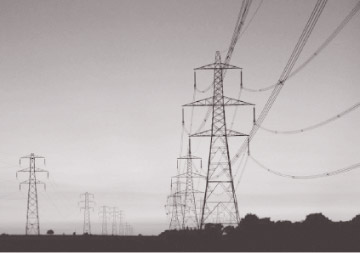|
Power and Energy Minister denies CPC allegations:
CEB on sound financial footing
By Manjula FERNANDO
|

Power and Energy Minister Patali Champika Ranawaka
|
Power and Energy Minister Patali Champika Ranawaka, denying
allegations the that Ceylon Electricity board (CEB) still owes the
Ceylon Petroleum Corporation (CPC) staggering amounts of money said the
systematic use of hydro power and strict financial regulations helped
the CEB record over Rs. 5 billion in profits after 10 years and zero its
overdrafts with the People’ s Bank in 2010.
He said it was an unfair and arbitrary decision by the CPC to revise
the prices of heavy oil supplied to the CEB and more so because it was
taken after their (CEB) announcement of profit making.
“As far as thermal power is concerned, we have incurred a nearly Rs.
27 billion loss. We are not a profit-driven organisation, therefore it
is unfair to suggest that the CPC is losing because of the CEB. We
wanted to prove a point that we can earn profits if we really work at
it. And we actually proved it.” Minister Ranawaka said.
He said despite the profit recorded last year, the CEB may incur a
loss of Rs. 16 billion in 2011 especially if the rainfall is meagre
among other factors.
The Minister also said that Sri Lanka has not completely abandoned
the idea of introducing nuclear power as a source of generating
electricity in 2025. Given the current state of affairs, Minister
Ranawaka said Sri Lanka will have a tough battle in meeting its rising
demand for energy in the future even if they resort to nuclear power.
Q: The Ceylon Electricity Board announced an over Rs. 5
billion operational profit for 2010. The CPC alleged that this profit
was possible due to the supply of oil to the CEB by them on
concessionary rates and over losses they incurred as a result? Is it
true?
 A: No, it is not true. The CEB recorded a great achievement.
For the past 10 years the CEB has been incurring serious financial
losses. From 2000 to 2009, the CEB had recorded a Rs. 117 billion loss.
During this period, the CEB owed the CPC nearly Rs. 52 million. It was
also getting subsidies amounting to Rs. 25 billion from the Treasury.
This was the financial situation of the CEB till 2009. A: No, it is not true. The CEB recorded a great achievement.
For the past 10 years the CEB has been incurring serious financial
losses. From 2000 to 2009, the CEB had recorded a Rs. 117 billion loss.
During this period, the CEB owed the CPC nearly Rs. 52 million. It was
also getting subsidies amounting to Rs. 25 billion from the Treasury.
This was the financial situation of the CEB till 2009.
In 2010 we paid back all CEB dues to the CPC, a total of Rs. 16,370
million. Thus, I believe this is a very unfair allegation. For the first
time after so many years, we have paid back the dues owed by the CEB to
the CPC.
In 2008, when the price of a crude oil barrel hit an all-time high,
the Government took a decision to subsidise fuel supplies to thermal
plants. The Government also ordered the CEB to remove the fuel surcharge
on customers’ electricity bills. That in turn made the CEB incur heavy
losses, thus compelling it to withhold payments to the CPC. Yet, we
agreed on September 1, 2010 to increase the price of heavy fuel from Rs.
26 per litre to Rs. 40.
When we generate electricity using fuel, the generation, transmission
and distribution costs per unit add up to Rs. 19.00. But we are selling
a unit to our consumers at Rs. 13.00, which means that we are losing Rs.
6.00 from one kilo watt hour.
As far as thermal power is concerned, we have incurred a nearly Rs.
27 billion loss. We are not a profit-driven organisation, therefore it
is unfair to suggest that the CPC is losing because of the CEB.
There is a staggering Rs. 7,000 million bill for street lights which
has never been accounted for by any State body. But we have not
disconnected a single street light because of the non-payment of bills.
We are driven by social responsibility. Government institutions,
hospitals and Security Establishments in particular owe us Rs. 12
billion. We have not yet disconnected the power supply of any of these
parties.
 Q: The CEB was considered a white elephant that was beyond
salvaging. How was this profit possible? Q: The CEB was considered a white elephant that was beyond
salvaging. How was this profit possible?
A: Due to strict financial regulations and systematic use of
hydro power. In addition, we stuck to a merit order within the
establishment and saved a lot of money. The strict guidelines followed
in material procurement saved us nearly Rs. 1.7 billion. Proper human
resource management also paid dividends and we reduced our losses from
Rs. 14.58 billion to Rs. 13.3 billion.
We also switched the generator fuel so that we could save on our fuel
bills. The CEB, as the biggest customer of People’s Bank, reached an
agreement with the bank to bring down the interest rate on our
overdraft. For the first time in history, the CEB in 2010 zeroed its
overdraft. Financially, the CEB is on a very sound footing now.
The crisis in the CPC is because of a technical issue in the
refinery. If you put 100 barrels of crude oil to the refinery, the
outcome would be 24 barrels of diesel, 10 barrels of petrol, 13 barrels
of kerosene and two units of LPG. The efficiency is just 50 percent. The
refinery is highly inefficient and the CPC’s main problem lies there.
Therefore, I deny the claim that the CPC is in a financial crisis due to
CEB’s debts.
The heavy fuel that we buy from the CPC is a residual fuel, it is a
byproduct. In the 1980s they dumped this byproduct to the Kelani River
as waste. The Environmentalists raised an issue over this practice.
Thereafter, the CPC decided to set up the Sapugaskanda plant to burn the
byproduct. We are buying this byproduct from them and doing them a
favour. They are producing 40 percent of heavy fuel in the process of
refining crude oil into fuel which could be sold. The CPC should rectify
this flaw first.
Thermal power plants
Q: For how long are we going to continue thermal power
generation in the country?
A: It’s a temporary thing. After 2016 we will be able to
achieve financial sustainability. Because of the increase in the demand
we have to depend on thermal power. What we could do to overcome the
present crisis is to diversify the sources. The CEB has made a huge
mistake by relying entirely on large hydros in the 1990s.
In 1995 we almost tapped our total hydro potential with the
completion of Mahaweli projects. At the time, a percent of our power
generation was by hydro power. Then came the major drought. There were
regular power cuts and to add to the woes there was a surge in demand
for power during the 1996 World Cup. At the time we had nearly six-hour
power cuts. Today, here in Sri Lanka, people watch the ICC World Cup
2011 on over 4.2 million TV sets. But we have an uninterrupted power
supply!
In India there are power outages lasting from six to eight hours. In
Bangladesh and Pakistan power cuts last between 12 and 16 hours.
After the 1995 crisis we introduced thermal power to the country.
Gradually, this sector started to dominate the scene and nearly 65 to 70
percent of the electricity came from thermal sources. This led to
serious repercussions when the oil prices skyrocketed in 2006. It
created a huge financial crisis, resulting in major losses to the CEB as
well as the CPC. The loss to the CEB was around Rs. 33 billion in 2008
alone.
The CEB is now in the process of diversifying its generation sources.
We have already introduced coal power. We are going to introduce
Liquified Natural Gas (LNG) - this generates cleaner energy than coal
and thermal sources. We are also going to tap non-conventional renewable
energy sources such as solar, wind, geothermal, tidal wave and modern
biomass. We are going to induce more and more renewable energy into our
system. These are the strategies that the CEB will try out in the near
future to overcome the crisis of thermal dependency.
Q: The CEB aspires to light up the entire country by 2012. How
realistic is this dream?
A: We have already reached many parts of the country. Our aim
is to install 4,000 new transformers so that each village could be
illuminated under this expedited program. But we are going to adopt a
different strategy for environmentally sensitive areas, small islets and
sparsely populated hilly areas. Providing electricity to such places
from the national grid is a very costly affair. We will give them
renewable solutions such as solar, wind and mini hydro projects. This
new package form of electrification will be introduced this year.
For example, I was met by Rathugala Vedda today. There are 32
families in his village. We need Rs. 57 million to light up this
village. This means for each family we have to spend nearly Rs. 1.5
million. With that money we could build each family a new house near the
grid instead of taking the power supply to this remote village.
Q: What is the situation in Jaffna and the liberated areas in
the North and the East?
A: In the East, under the Re-awakening of the Eastern Province
program, rural and remote electrification projects are continuing. In
Jaffna there is a problem connecting Jaffna peninsula with the rest of
the country because the main line from Vavuniya to Chunnakkam has been
completely destroyed by the LTTE. We are now in the process of restoring
this power line and the work is to be completed by 2014.
As far as islets such as Kytes are concerned, we have planned to
supply them with solar energy and other off-grid energy solutions.
90 unit limit
Q: There is a 90 unit concessionary rate for households. Is
this a fair allocation as far as an average household is concerned? What
is the percentage of households using less than 90 units?
A: Seventy percent of households use less than 90 units. But
that is besides the point.
If you equally divide the number of units generated by hydro power in
2010 by the number of households in Sri Lanka, each house gets 73 units.
The hydro power cost per unit would be less than six rupees. After this
73, we have to fire our thermal plants. Hence, anyone who consumes more
than 90 units are required to bear the costs of thermal power
generation. That is our argument.
Q: There were allegations that the CEB was ruthlessly
profit-driven and there were instances that the power supply to
hospitals was disconnected in the middle of surgeries, etc.?
A: No, that is not true; not a single hospital has been
disconnected. We spare military points as well. There were reported
incidents of power interruptions in hospitals, but that was due to their
internal faults, not due to any action of the CEB.
But hospitals and other Government institutions still owe us nearly
Rs. 12 billion.
Q: What are your projections for 2011?
A: In 2011 and 2012, we are more or less focusing on our
development projects. We showed the world that the CEB can be a
financially viable entity. We wanted to prove that point and we did it.
No one expected that it was possible. That is why they are disturbed,
especially the diesel mafia, they are very much worried. I got strongly
worded letters from the diplomatic community, international community
and so called entrepreneurs, threatening me that they would go to Courts
since I did not dispatch their high cost plant. But we were adamant and
we completely changed the CEB’s financial structure within six months of
my assuming duties as the minister.
We are investing Rs. 350 billion on development in the power sector.
The cost is seven-fold compared to the accelerated Mahaweli project
which was Rs. 50 billion. The projects include Puttlam coal power plant,
Upper Kotmale project, transmission projects, rural electrification and
upgrading of the Colombo system.
Q: What is your profit forecast for 2011?
A: We won’t make profits this year. The projection is that
there will be a nearly Rs. 16 billion loss.
Q: But even last year, the projection was a Rs. 40 billion
loss?
A: Yes. But it all depends on rainfall and many other factors.
No concessionary rates
Q: The CPC has said that they would discontinue the supply of
oil to the CEB at concessionary rates from next year. What impact will
this make on your overall performance?
A: The CPC cannot make such arbitrary decisions. The decision
to provide oil at concessionary rates was made by President Rajapaksa in
2008 with the rise of fuel prices in the world market. Any revisions
thereafter should be made in a democratic way.
Even the CEB cannot make any decisions alone. What if we take a
decision to disconnect the 700,000 street lights or cut the power supply
to Courts premises and hospitals for non-payment of bills? It is a
serious thing. We cannot proclaim that rural electrification has to be
stopped because it is too costly. The CEB has to spend Rs. 100,000 to
one million rupees to illuminate a rural household whereas we charge
just Rs. 12,500 from them.
The CEB is not a profit-oriented institution. We wanted to prove a
point that we can earn a profit if we really work at it. That was it.
Just like the Armed Forces proved the point that the LTTE can be
defeated when everyone else said it was impossible!
Q: Are there house-to-house inspections being conducted to
detect power piracy?
A: Yes, we are currently engaged in that. We want to deal
severely with those who engage in power theft. But the current Act
handicaps us in taking effective measures. According to the Act we have
to inform the householders three days before we make an inspection
visit. This is ridiculous. We are going to amend the Act within the
course of this year.
Q: Sri Lanka has been considering nuclear power as a source
for electricity generation. Is this still on the cards?
A: I will be the happiest if we can meet our demand without
nuclear energy. The nuclear fission using uranium is a very hi-tech
operation and highly dangerous in the event of accidents as proved in
Fukushima. However, fossil fuel will be exhausted one day. Moreover, the
burning of fossil fuel causes global warming.
Everyone knows the limitations of nuclear power. But we have to study
this and have it as an option. New technology will emerge in the future.
We are not going to construct this plant tomorrow. It will be on our
cards by 2025. Either there will be a safer technology to deal with
nuclear power by then or the whole world would decide to shut down
nuclear plants. But it is not wise to abandon this idea altogether. Even
today we cannot claim to be 100 percent safe from a nuclear threat.
India has 17 reactors in its territory and some of them are very much
close to Sri Lanka.
Q: Is it impossible to meet the country’s energy demand
without nuclear power?
A: We cannot meet the demand even with nuclear power. Our
current maximum consumption is about 13.6 Terawatts. It has been
estimated that in 2050 this will rise to 30 Terawatts. We must generate
another 16 terawatts to meet the demand. If you use all these firm
energies, large hydro, coal, thermal, gas and nuclear, we could generate
only another six Terawatts. The shortfall will be 10 Terawatts. This
will continue to be a problem unless humans change their lifestyles and
shed their greediness. |

